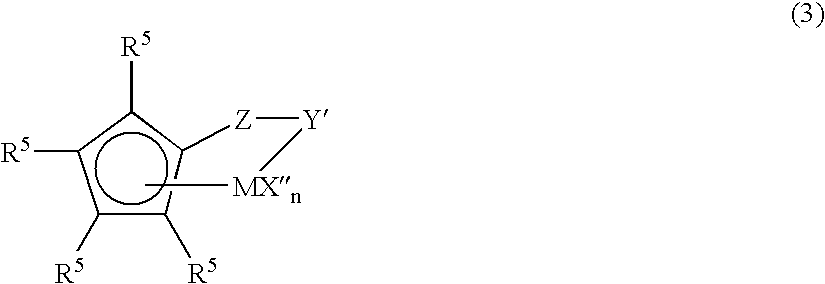Ultrahigh-molecular ethylene polymer
a technology of ethylene polymer and high molecular weight, applied in the field of ultrahigh molecular weight ethylene polymer, can solve the problems of non-uniform molded articles, insufficient utilization of properties, and thermal melt, and achieve the effect of improving the balance between moldability and melting
- Summary
- Abstract
- Description
- Claims
- Application Information
AI Technical Summary
Benefits of technology
Problems solved by technology
Method used
Image
Examples
example 1
(Preparation of Compound Having Hydrogenation Ability (D))
[0224] A 3 wt % hexane suspension containing 30 mmol of titanocene dichloride available from Wako Pure Chemical Industries, Ltd. and 60 mmol of a 1M trimethylaluminum hexane solution were stirred at room temperature for 100 hours to prepare a Tebbe reagent.
[0225] (Polymerization of Ethylene: Preparation of Ethylene Homopolymer (A))
[0226] Isobutane, ethylene, hydrogen, a metallocene catalyst and a Tebbe reagent were continuously fed to a vessel-type polymerization reactor equipped with a stirrer to produce polyethylene (ethylene homopolymer) at a rate of 10 kg / Hr. As hydrogen, hydrogen purified to 99.99 mole % or more by making contact with molecular sieves was used. As the metallocene catalyst, one in which a mixture of [(N-t-butylamide)(tetramethyl-η5-cyclopentadienyl)dimethyl silane]titanium-1,3-pentadiene, bis(hydrogenated tallow alkyl)methylammonium-tris(pentafluorophenyl)(4-hydroxyphenyl)borate and triethylaluminum i...
example 2
[0227] Polymerization was carried out in the same manner as in Example 1 except that the Tebbe reagent was fed at 0.013 mmol / Hr. No bulk polymer was produced, nor was the slurry discharge tube clogged either in this case, and stable continuous operation was achieved. The average molecular weight of the obtained polyethylene determined from the intrinsic viscosity in decalin (135° C.) was 2.1 million, the density was 0.9300 g / cc and the crystallinity was 52%. These and other measurement results of this Example are shown in Table 1.
example 3
[0228] Polymerization was carried out in the same manner as in Example 1 except that the Tebbe reagent was fed at 0.38 mmol / Hr. No bulk polymer was produced, nor was the slurry discharge tube clogged either in this case, and stable continuous operation was achieved. The average molecular weight of the obtained polyethylene determined from the intrinsic viscosity in decalin (135° C.) was 11 million, the density was 0.9235 g / cc and the crystallinity was 42%. These and other measurement results of this Example are shown in Table 1.
PUM
| Property | Measurement | Unit |
|---|---|---|
| Temperature | aaaaa | aaaaa |
| Fraction | aaaaa | aaaaa |
| Fraction | aaaaa | aaaaa |
Abstract
Description
Claims
Application Information
 Login to View More
Login to View More - R&D
- Intellectual Property
- Life Sciences
- Materials
- Tech Scout
- Unparalleled Data Quality
- Higher Quality Content
- 60% Fewer Hallucinations
Browse by: Latest US Patents, China's latest patents, Technical Efficacy Thesaurus, Application Domain, Technology Topic, Popular Technical Reports.
© 2025 PatSnap. All rights reserved.Legal|Privacy policy|Modern Slavery Act Transparency Statement|Sitemap|About US| Contact US: help@patsnap.com



